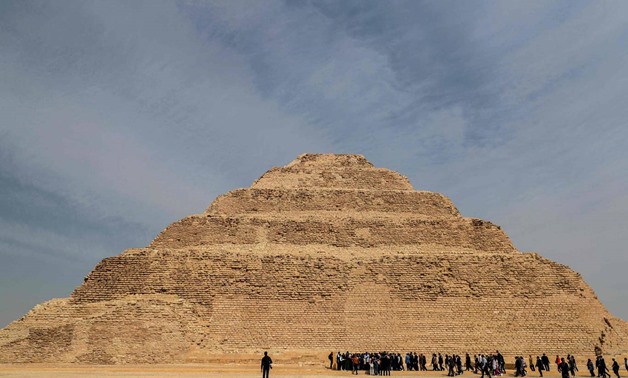
File - Djoser Pyramid.
CAIRO - 7 March 2020: The acclaimed British online publisher of news Independent highlighted the inauguration of Djoser Pyramid.
Independent wrote that an Egyptian pyramid that’s believed to be the first one ever built reopened to the public on 5 March after a 14-year restoration project costing almost $6.6m (£5m).
The English news website added that Djoser’s Step Pyramid, located west of Cairo near Saqqara archaeological site, was built some 4,700 years ago.
On March 5, Egypt’s prime minister Moustafa Madbouly inaugurated Djoser Pyramid after 14 years of restoration.
Head of the Projects Sector at the Ministry of Antiquities Waad Abul Ela previously said that the restoration of Djoser Pyramid in Saqqara Antiquities Area has been completed in February.
The head of the projects sector at the Ministry of Antiquities told the press that the restoration of the Pyramid of Djoser was carried out using modern scientific methods agreed upon globally.
The restoration process took place under the supervision of many leading archaeologists.
The Ministry of Antiquities has completed the restoration project of the Pyramid of Djoser and developed its surrounding area, within the framework of the ministry's plan to preserve and develop archaeological sites and improve the services for visitors.
The restoration project included risk reduction works. The internal and external restoration of the pyramid included the development of the paths leading to the pyramid and the internal corridors leading to the burial well, in addition to the restoration of the stone sarcophagus, and the walls.
Secretary General of the Supreme Council of Antiquities Mostafa Waziri said that the restoration project started in 2006 and came to a halt in 2011, before resuming again at the end of 2013.
The outer facades of the pyramid, the buildings and stairs of the southern entrance and the eastern entrance were also restored. This is in addition to a thorough restoration and cleaning of all internal corridors of the pyramid, and the installation of the loose stones.
Waziri inspected the pyramid and its surrounding area on Feb. 24. He explained that the Saqqara Pyramid restoration project is one of the most important restoration projects implemented by the ministry, as the Pyramid of Djoser is the oldest stone building in the world.
Assistant Minister for Investment and Financial Resources Development Iman Zeidan said the work of developing the Saqqara Pyramid area included paving the way from the gates of the archaeological area to the pyramid’s entrance to facilitate the arrival of visitors in general and those with special needs in particular.
Supervisor of the Department of Development of Archaeological Sites and Museums in the Office of the Minister of Tourism and Antiquities Dalia Khattab explained that the process of developing the region was carried out according to an integrated plan of action in cooperation with the private sector, with the aim of preserving the archaeological area and providing amenities and services to visitors.
The restoration of Djoser Pyramid was among the priorities of the government, as it is one of the most important monuments in the cemetery of Saqqara, west of the ancient city of Memphis. The pyramid is also called the Step Pyramid, and was built by Amenhotep during the 27th century BC to bury Djoser.
It is worth mentioning that the cabinet allocated 15,398150 LE to support the restoration and maintenance of Djoser Pyramid.
The maintenance and restoration of the stunning Pyramid of Djoser had started following the issuance of a UNESCO report.
The restoration and the maintenance of the pyramid has stopped since 2011, after the UNESCO report issued in September of the same year, stating that the exterior facades of the pyramid has suffered from lack of maintenance over the centuries.
In addition to the damage caused by the removal of the dirt blocks, which led to the creation of many large cavities in several areas, and the appearance of many blocks seriously hanging without the existence of any pillars to protect them.
The report also confirmed the existence of some problems in the restoration work. Later rumours spread that the pyramid was removed from the World Heritage List.
The restoration work of the pyramid began in 2006, and was planned to end in 2009. But fears for the safety of the pyramid, increased after UNESCO’s report, which acknowledged that many irregularities occurred from the company responsible about its maintenance.
These irregularities were technical, particularly in the use of limestone to plug the openings which emerged from the pyramid body, the matter that led to the distortion of the pyramid external shape. In addition to the excessive load on the pyramid, which became a real danger to the pyramid.

Comments
Leave a Comment